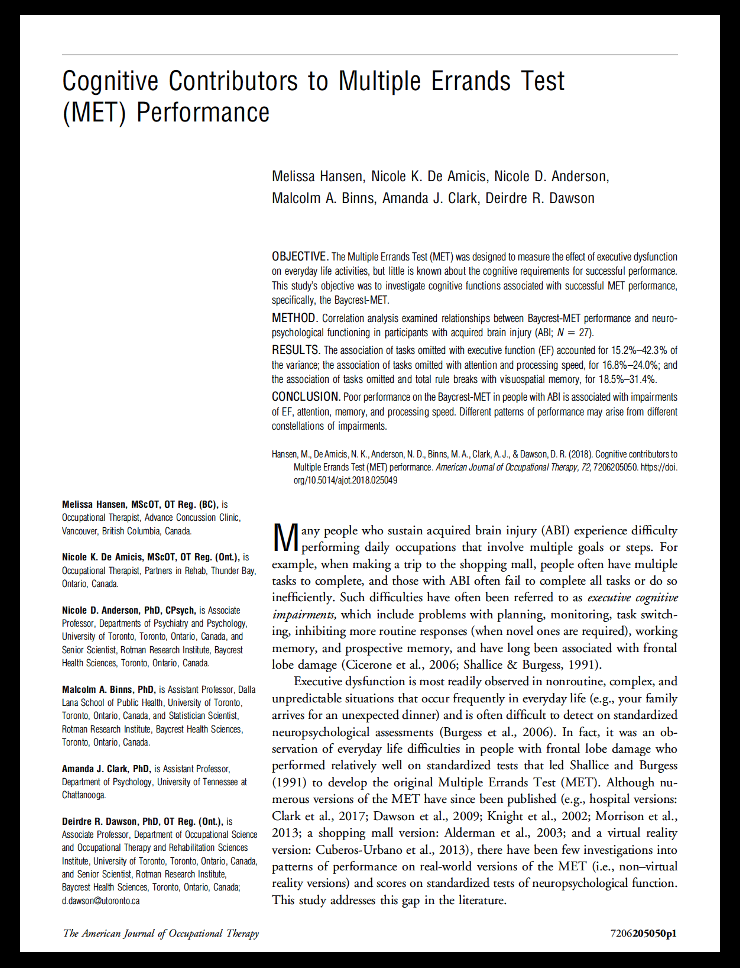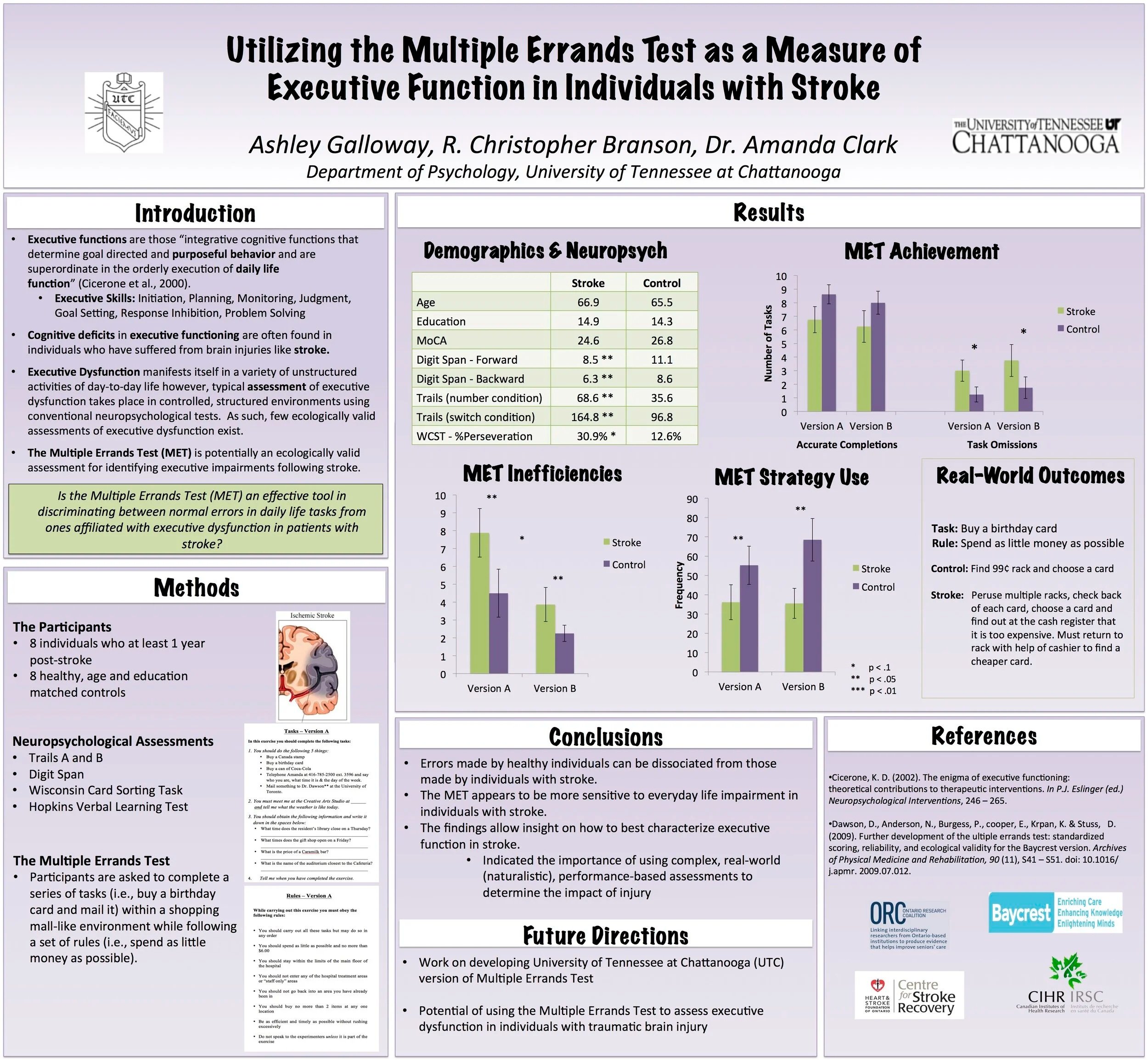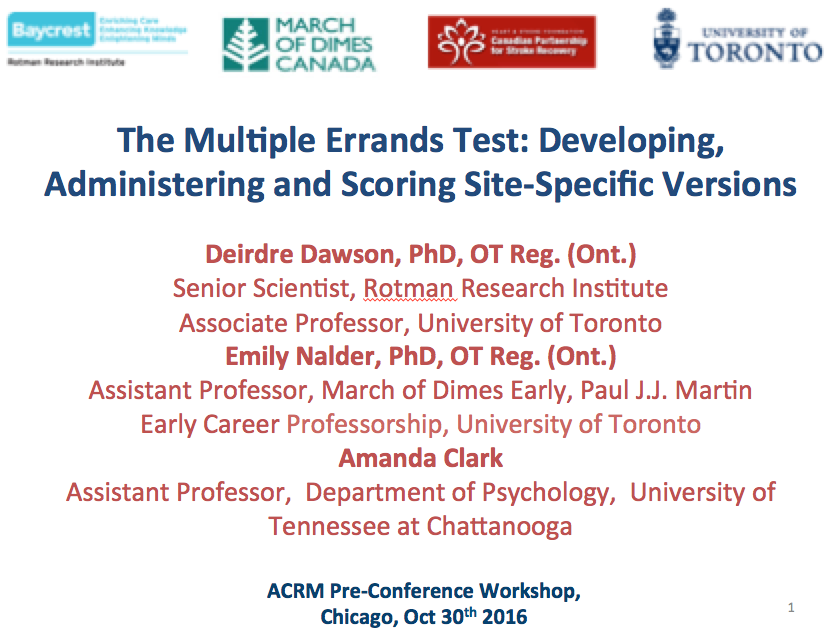Assessing the INJURED
... assessing cognition in the healthy, the aging, the injured, and the malingering ...
This area of scholarship focuses on assessing the impact of acquired brain injury on everyday life as. Before the Covid-19 pandemic, this line of research involved having older adults with stroke and Parkinson’s disease come to campus or a research hospital to complete the Multiple Errands Test (MET). When that research became unsafe to continue, I pivoted my lab members who were interested in brain injury to explore questions around detecting sport-related head injury in young adults (who we could continue to recruit safely). In addition, I have also engaged with campus colleagues to improve coach approachability and athlete perceived norms toward reporting concussion, and to develop a virtual Tai Ji system for those with spinal cord injury.
Examining Executive function with the multiple errands Test
Errors of everyday living that result from executive dysfunction are incredibly common but it is incredibly difficult to discriminate normal errors of everyday action from pathological ones that are associated with healthy aging and/or acquired brain injury. Furthermore, determining the impact of these errors on everyday life is unreliable.
The Baycrest - Multiple Errands Test
I collaborated with colleagues at the Rotman Research Institute where we focus on better assessing the everyday life impact of frontal love injury using the Baycrest version of the MET. My contribution to that work involves measuring the reliability and construct validity of the measure, developing and testing an alteration version and co-supervising graduate students who examined the necessary cognitive contributors to successful MET performance. This line of my research program has resulted in: publication of peer-reviewed articles in Neuropsychological Rehabilitation and Clinical Rehabilitation, development and publication of a researcher/clinician/practitioner manual for the MET, two, full-day, pre-conference workshops to present the MET manual, invited lectures to discuss the utility of the MET, and numerous presentations at national and international conferences.
The University of Tennessee at Chattanooga - Multiple Errands Test
One of my primary research goals for my Assessing Cognition Lab was to develop a version of the MET on the UTC campus. Together with two graduate students we have tested this UTC-MET within a Parkinson's disease population. This work involved, securing a a Faculty Research Grant to support participants (valued at $2,250), an ORAU Powe Faculty Enhancement Award application (unfunded), two graduate student theses (R. Christopher Branson & Allen Nida), a Provost Student Research Award to fun the purchase the Texas Functional Living scale (TFLS) to determine construct validity, and numerous posters and presentations at regional, national and international conferences.
Detecting and Characterizing SPORT RELATED Head Injury
In 2020 I joined a research group that was working to identify methods that could be used to detect a sport-related head injury. The team was working on the development of the tool SportGait. SportGait is a smart phone platform that provides a battery of neurocognitive and neuromotor assessments to support concussion evaluation, return-to-play decisions, and tracking recovery. Its tools include gait analysis (e.g., the BKG™ Gait test), cognitive tests (a version of the Conners Continuous Performance Test), balance assessments (BESS), and functional measures such as the NIH 4-Meter Gait. I led the University of Tennessee at Chattanooga arm of this project. We published a collection of our findings in the Journal of Pediatric Neuropsychology. After validating the measure, my graduate student Melissa Materia utilized the SportGait platform to explore whether its tools are sensitive to ‘sandbagging’ of performance to avoid detection of an actual brain injury when it occurs on the field. Melissa is currently completing doctoral training at University of North Texas. She just proposed her dissertation and is now turning some of her writing attention to her thesis. I look forward to mentoring her through that process as a senior author.
In 2014-2015, Haley Popp completed a departmental honors thesis project under my direction where she examined how a history of sport-related head injury was related to performance anxiety. Through her thesis, Haley demonstrated that athletes with a history of musculoskeletal injury and those with a history of head injury were equally anxious about re injury.
ICAAR - Improving Coach Approachability and Athlete Perceived Norms Toward Reporting Concussion: Attitudes and behaviors toward concussion reporting among high school football players.
Neglecting to report possible concussion presents a very dangerous problem. Frequently reported barriers to reporting concussions include: a lack of knowledge regarding concussion symptoms, misperceptions regarding the severity of the injury, a desire to continue playing, and a belief that removing oneself from play will let coaches and teammates down.
In direct response to a funding call from the NCAA and Department of Defense we proposed the iCAAR program. This program was:
a collaboration between me, Dr. Shellie Acocello (Athletic Training), Dr. Nancy Fell (Physical Therapy), Dr. Barry Kamrath (Education), and Dr. Kate Rogers (Psychology)
an application for $357,449 to examine the effectiveness of transformational leadership training for coaches and social consensus building for athletes in reducing barriers to concussion reporting
successful in the first round of decisions but was not funded in the final round of the competition
A VIRTUAL Tai Ji SYSTEM
The Virtual Tai Ji System involves integrating the healing art of TaiJi with a series of cutting-edge computer technologies, including 4D sensor technology. The program is in development for use in individuals who would be unable to participate in standing TaiJi. We are currently assessing the physical and psychological effects of the VJTS on individuals with fibromyalgia and seek to continue assessing the efficacy of the program in individuals with spinal cord injury.
This project is:
funded by a CRISP grant ($8,000)
a collaboration with Dr. Yu Liang (Computer Science), Dr. Dalei Wu (Computer Science), Dr. Zibin Guo (Anthropology) and Dr. Nancy Fell (Physical Therapy)
seeking additional funding support via a NSF R15 grant proposal and the THEC-supported Center of Excellence in Applied Computational Science and Engineering

















